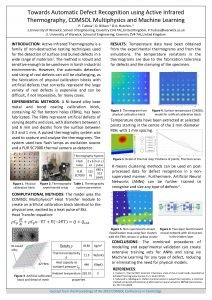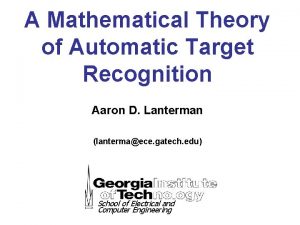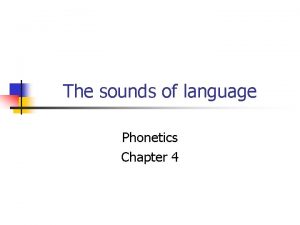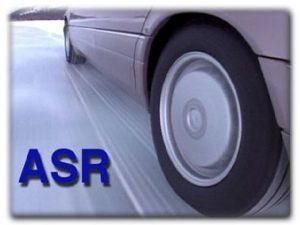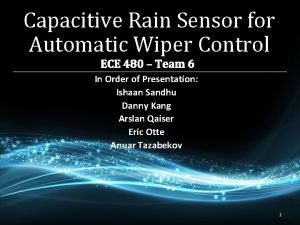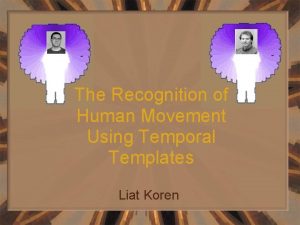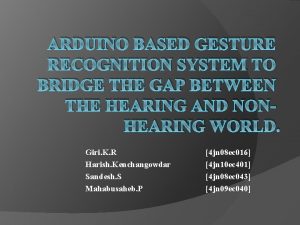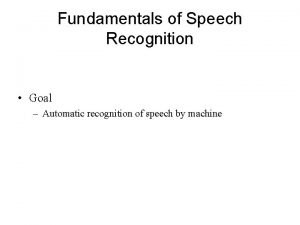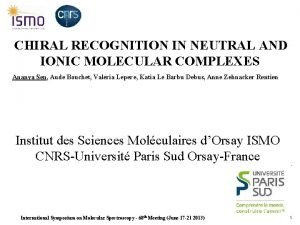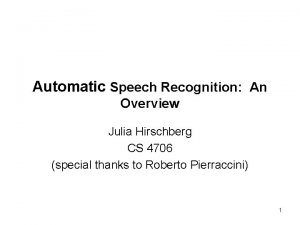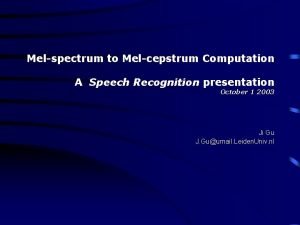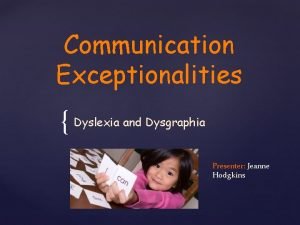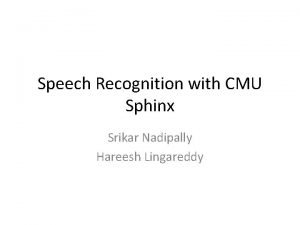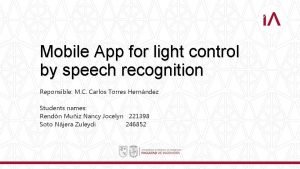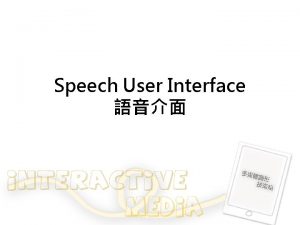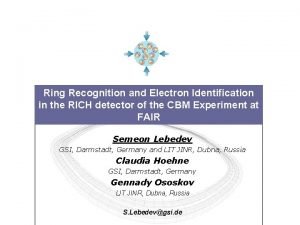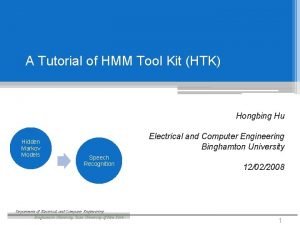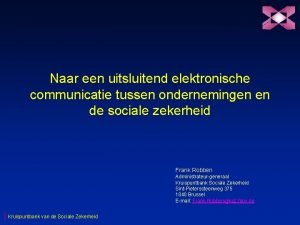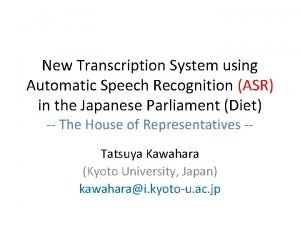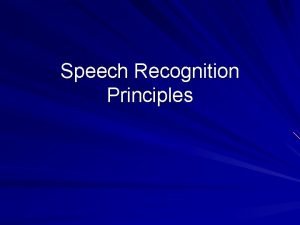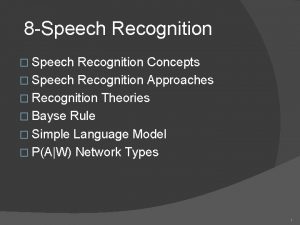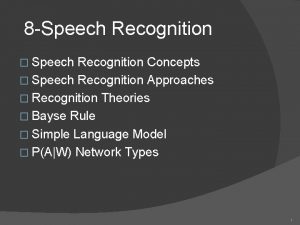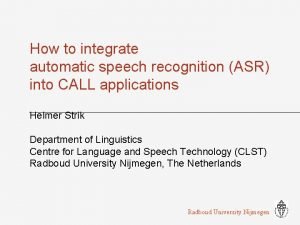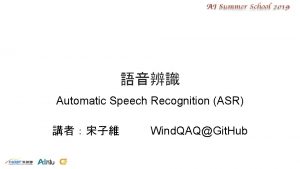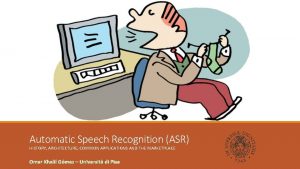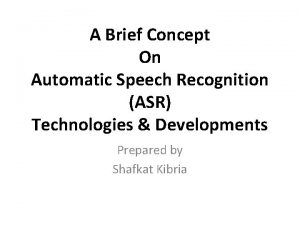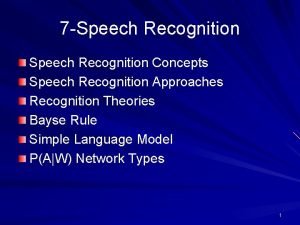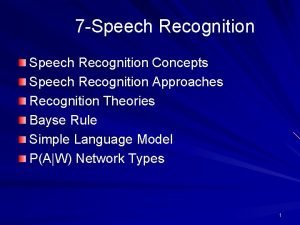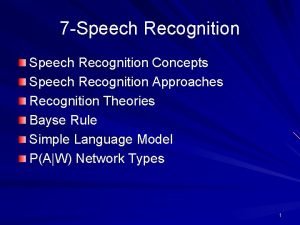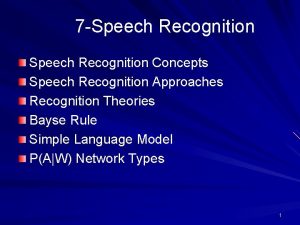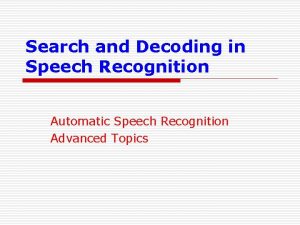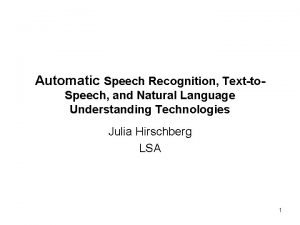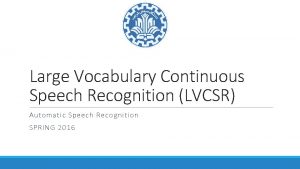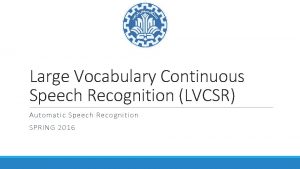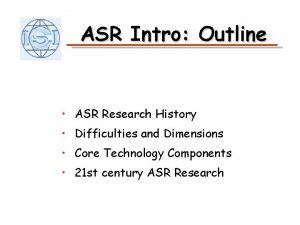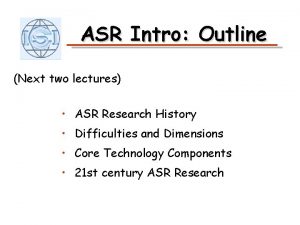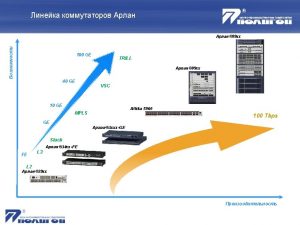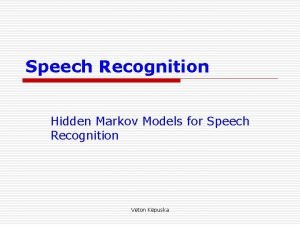Transcription System using Automatic Speech Recognition ASR for




![Review of ASR technology (1/2) • Broadcast News [world-wide] – Professional anchors, mostly reading Review of ASR technology (1/2) • Broadcast News [world-wide] – Professional anchors, mostly reading](https://slidetodoc.com/presentation_image/c7e330dbd2fdd95a43f66d799515617c/image-5.jpg)
![Review of ASR technology (2/2) • Telephone conversations [US] – Ordinary people, speaking casually Review of ASR technology (2/2) • Telephone conversations [US] – Ordinary people, speaking casually](https://slidetodoc.com/presentation_image/c7e330dbd2fdd95a43f66d799515617c/image-6.jpg)




















- Slides: 26

Transcription System using Automatic Speech Recognition (ASR) for the Japanese Parliament (Diet) Tatsuya Kawahara (Kyoto University, Japan)

Brief Biography • • 1995 -96 2003 - • 2003 -06 • 2006 - Ph. D. (Information Science), Kyoto Univ. Associate Professor, Kyoto Univ. Visiting Researcher, Bell Labs. , USA Professor, Kyoto Univ. IEEE SPS Speech TC member Technical Consultant, The House of Representative, Japan Published 150~ papers in automatic speech recognition (ASR) and its applications Web http: //www. ar. media. kyoto-u. ac. jp/~kawahara/

Contents 1. Review of ASR technology 2. ASR system for the Japanese Diet 3. Next-generation transcription system of the Japanese Diet

Trend of ASR Informal Phone conversation Classroom lectures style Formal Spontaneous speech Formal presentation Reading/ Re-speaking one Business meetings Parliament Broadcast news Number of speakers multiple
![Review of ASR technology 12 Broadcast News worldwide Professional anchors mostly reading Review of ASR technology (1/2) • Broadcast News [world-wide] – Professional anchors, mostly reading](https://slidetodoc.com/presentation_image/c7e330dbd2fdd95a43f66d799515617c/image-5.jpg)
Review of ASR technology (1/2) • Broadcast News [world-wide] – Professional anchors, mostly reading manuscripts – Accuracy over 90% • Public speaking, oral presentations [Japan] – Ordinary people making fluent speech – Accuracy ~80% (close-talking mic. ) • Classroom lectures [world-wide] – More informal speaking – Accuracy ~60% (pin mic. )
![Review of ASR technology 22 Telephone conversations US Ordinary people speaking casually Review of ASR technology (2/2) • Telephone conversations [US] – Ordinary people, speaking casually](https://slidetodoc.com/presentation_image/c7e330dbd2fdd95a43f66d799515617c/image-6.jpg)
Review of ASR technology (2/2) • Telephone conversations [US] – Ordinary people, speaking casually – Accuracy 60% 85% • Business meetings [Europe/US] – Ordinary people, speaking less formally – Accuracy 70% (close mic. ), 60% (distant mic. ) • Parliamentary meetings [Europe/Japan] – Politicians speaking formally – EU: plenary sessions: 90% – Japan: committee meetings: 85%

Deployment of ASR in Parliaments & Courts • Some countries – Steno-mask & Voice writing – Re-speaking Commercial dictation software • Some local autonomies in Japan – Direct recognition of politicians’ speech • Japanese Courts – ASR for efficient retrieval from recorded sessions • Japanese Parliaments (=Diet) – to introduce ASR; direct recognition of politicians’ speech – Mostly in committee meetings …interactive, spontaneous, sometimes excited

Language-specific Issues in Japanese • Need to convert kana (phonetic symbol) to kanji • Conversion ambiguous many homonym (ex. ) KAWAHARA (カワハラ) → 河原 (not 川原) – Very hard to type-in real-time – Only limited stenographers using special keyboards can • Difference in verbatim-style and transcript-style (ex. ) おききしたいのですが ききたい(のです) – Re-speaking is not so simple – need to rephrase in many cases

ASR Architecture Signal processing X Depend on input condition P(X/W) Recognition Engine (decoder) P(W/X) ∝ P(W)・P(X/W) output: W=argmax P(W/X) Acoustic model P(X/P) Dictionary P(P/W) Language model P(W) Depend on application /a, i, u, e, o…/ 京都 ky o: t o 京都+の+天気

Current Status of ASR • Problems unsolved – Spontaneous/conversational speech – Noisy environments • Including distant microphones • Solutions ad-hoc – Collect large-scale “matched” data (corpus) • Same acoustic environment, speakers (10 hours~) • Cover same topics, vocabulary (~M words) – Prepare dedicated acoustic & language models • Huge cost in development & maintenance

Contents 1. Review of ASR technology 2. ASR system for the Japanese Diet 3. Next-generation transcription system of the Japanese Diet

ASR Research in Kyoto Univ. • Since 1960 s, one of the pioneers • Development of free software Julius • Research in spontaneous speech recognition – – 1999200120042003 - Oral presentations TV discussions Classroom lectures Parliamentary meetings

Free ASR Software: Julius • Developed since 1997 in Kyoto-U & other sites • Open-source multi-platform (Linux, Mac, Windows, i. Phone) • Open architecture – Independent from acoustic & language models Ported to many languages Ported to many applications (telephony, robot…) • Standard model for Japanese • Widely-used research platform http: //julius. sourceforge. jp


ASR modules oriented for Spontaneous Speech Signal processing X Corpus P(X/W) Recognition Engine (decoder) P(W/X) ∝ P(W)・P(X/W) Acoustic model Dictionary Language model Cover poor articulation Cover pronunciation variations Cover disfluencies & colloquial expressions Innovative techniques

ASR Performance • Accuracy – Word accuracy 85% (Character accuracy 87%) • Plenary sessions 90% • Committee meetings 80~ 87% – 90% seems almost perfect – No commercial software can achieve!! • Real-time factor 1 -3 – Latency in 10 min.

Related Techniques • Noise suppression & dereverberation – Not serious once matched training data available • Speaker change detection – Preferred – Current technology level seems not sufficient • Auto-edit – Filler removal easy – Colloquial expression replacement non-trivial – Period insertion still research stage

Contents 1. Review of ASR technology 2. ASR system for the Japanese Diet 3. Next-generation transcription system of the Japanese Diet

The House of Representatives in Japan • 2005: terminated recruiting stenographers • 2006: investigated ASR technology for the new transcription system • 2007: developed a prototype system and made preliminary evaluations • 2008: system design • 2009: system implementation • 2010: trial and deployment

ASR system: Kyoto Univ. model integrated to NTT engine Signal processing X Recognition Engine (decoder) P(X/W) Acoustic model P(X/P) Dictionary P(P/W) P(W/X) ∝ P(W)・P(X/W) Language model P(W) NTT Corp. Kyoto Univ. House /a, i, u, e, o…/ 京都 ky o: t o 京都+の+天気

Issues in Post-Editor • For efficient correction of ASR errors and cleaning transcript into document-style • Easy reference to original speech (+video) – by time, by utterance, by character (cursor) – Can speed up & down speech-replay • Word-processor interface (screen editor); not line editor – to concentrate on making correct sentences – Serious misunderstanding between system developers and stenographers!!

System Evaluation (@Kyoto) edit time (min) • Subjects: 18 students • Post-editing ASR outputs is more efficient than typing from scratch, regardless of the accuracy Those hard for ASR are also hard for human Type from scratch Post-edit ASR output 10 9 8 7 6 5 4 3 50 55 60 65 70 75 80 ASR accuracy 85 90 95

System Evaluation (@Kyoto) • Subjective evaluation correlates with ASR accuracy • Threshold in 75% to have ASR preferred 7 Usability score of ASR 6 5 4 3 2 1 50 55 60 65 70 75 80 85 ASR accuracy 90 95

System Evaluation (@House) • Subjects: 8 stenographers • System: proto-type • ASR-based system reduced the edit time, compared with current short-hand system – 78 min. 68 min. (for 5 min. segment) • Threshold in ASR accuracy of 80% – 75% degradation in edit time; a half say negative in using ASR

Side effect of ASR-based system • Everything (text/speech/video) digitized and hyper-linked Efficient search & retrieval • Less burden? may work on longer segments? ? • Significantly less special training needed compared with current short-hand system

Conclusions • ASR of parliamentary meetings is feasible, given a large collection of data – ~100 hour speech – ~1 G word text (minutes) – Accuracy 85 -90% • Effective post-processing is still under investigation • Automatic translation research is also ongoing
 Automatic defect recognition
Automatic defect recognition Automatic target recognition
Automatic target recognition Language
Language Speech phonetic transcription
Speech phonetic transcription System collections generic
System collections generic Tcs sistem
Tcs sistem Rain sensing automatic car wiper project
Rain sensing automatic car wiper project The recognition of human movement using temporal templates
The recognition of human movement using temporal templates Hand gesture recognition project using arduino
Hand gesture recognition project using arduino Shape matching and object recognition using shape contexts
Shape matching and object recognition using shape contexts Matlab fingerprint recognition
Matlab fingerprint recognition Template matching
Template matching Kinect for windows runtime
Kinect for windows runtime Fundamentals of speech recognition
Fundamentals of speech recognition Deep learning speech recognition
Deep learning speech recognition Ionic speech recognition
Ionic speech recognition Julia speech recognition
Julia speech recognition Melspectrum
Melspectrum How a dyslexic person sees text
How a dyslexic person sees text Cmu speech recognition
Cmu speech recognition Speech recognition
Speech recognition Speech recognition app inventor
Speech recognition app inventor Dragon speech recognition
Dragon speech recognition Electron speech recognition
Electron speech recognition Htk tutorial
Htk tutorial Global tendensiyalar
Global tendensiyalar Asr werkgeversportaal
Asr werkgeversportaal
